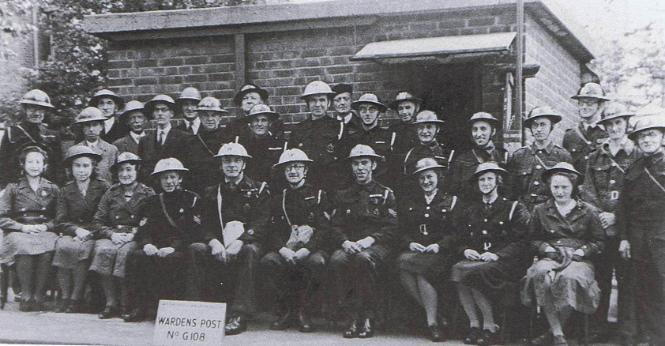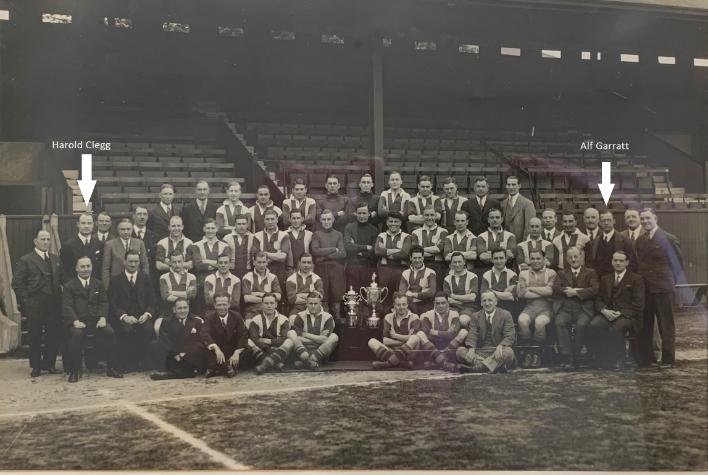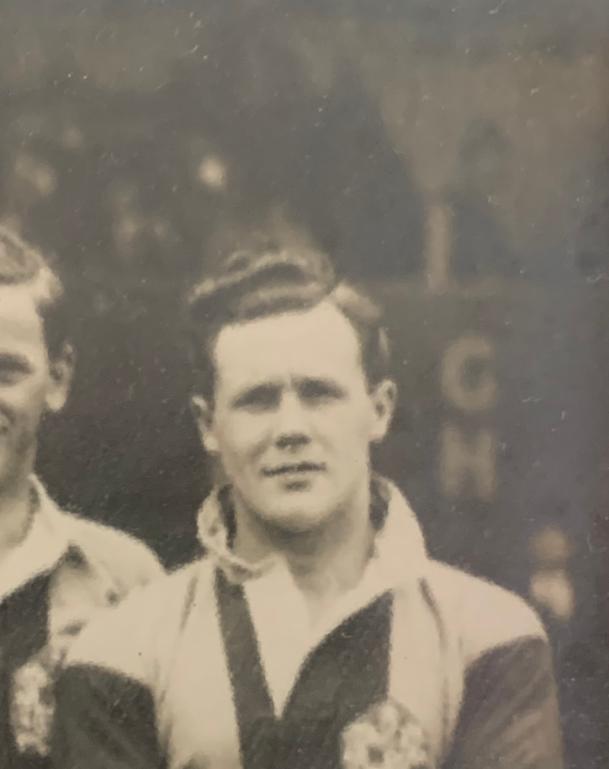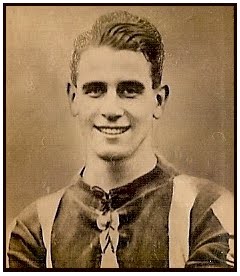They Also Served - Dulwich Hamlet and the Civil Defence Services
11/07/2023 - 1.48
Steve Hunnisett
In previous seminar talks and blog posts, we have looked at the Dulwich Hamlet players who perished in two World Wars but in this piece we’re looking at club players and officials who survived the war and served closer to home, in the Civil Defence or as it was known prior to August 1941, the Air Raid Precautions Services.
So far, we’ve discovered, mainly through reading wartime programmes and club handbooks from the immediate post-war years that 87 Hamlet players and officials served in some capacity or another during World War Two. Of these, at least 33 served in the RAF as aircrew, with the remainder mostly split between the Navy and the Army and as we have previously discussed, six of these, plus one former player paid the ultimate price.
Apart from the Armed Services, there was another avenue open to those who wished to serve and which especially suited those perhaps too old to join the “fighting” services or those known at the time as Conscientious Objectors – people whose personal or religious beliefs forbade them to take lives but who had no problem in putting their own lives on the line in order to save others.
In addition to those in the fighting services, no doubt in common with many other clubs, Dulwich Hamlet had a number of officials, players and at least one former player who also served on the Home Front in the Civil Defence Services.
As we’ve already seen, the Civil Defence organisation in the UK was originally known as the Air Raid Precautions or ARP Service and was initially established in 1935. Although overall control rested with the Home Office, local control was at a municipal level. The country was divided into twelve Civil Defence regions, of which London was the only city large enough to warrant being a region in its own right and covered roughly the Metropolitan and City of London Police areas. The overall control for London area rested with a Civil Commissioner, Admiral Sir Edward Evans who was based in a purpose built underground control room adjacent to the Geological Museum at the junction of Cromwell Road and Exhibition Road. London was further sub-divided into groups of between five and eleven neighbouring boroughs, each placed under the command of one of them.
The largest part of the Civil Defence Services was that of the Air Raid Wardens, which at its peak numbered close to a million members. Perhaps our image of the wardens has been framed somewhat by Chief Warden Bert Hodges, Captain Mainwaring’s nemesis in ‘Dad’s Army’, who was brilliantly portrayed in the BBC series by Bill Pertwee. He is portrayed as a widely disliked, officious busybody who’s main purpose in life is shouting at people to “…put that light out”.

Bill Pertwee (on the right) as Chief Warden Hodges. Source: Steve Hunnisett
Strangely enough, during the “Phoney War” period at the beginning of the Second World War, this was how they were frequently viewed by the public and the music hall comedian Bud Flanagan had a long-running gag that ARP should not stand for Air Raid Precautions but instead for ‘Anging ‘Round Pubs!
By the outbreak of war, some 800,000 wardens had been recruited, the vast majority of whom were volunteers who only received payment of expenses. Many of the male wardens were veterans of the Great War, or even earlier conflicts and roughly one in every six wardens were women. Their main jobs were the enforcement of the Blackout but during an air raid, they would continue to patrol but would then act as Control Officers to co-ordinate the response to individual bomb incidents.

Wardens Post G108. Source: Steve Hunnisett
Dulwich Hamlet’s contribution to the Wardens’ Service was two-fold, with Honorary Secretary Harold Clegg serving as part of the Cheam Wardens’ Service and Honorary Treasurer Alf Garratt, who was a resident of Turney Road in Dulwich, serving at Post 61 in Goodrich Road. It would appear that Alf did not enjoy good health and he sadly died of natural causes in 1944, at the age of 58. In addition, we know of at least two others associated with the club who served as Wardens – these were Richard and Pyarea Adams, who were the parents of wartime player and Arnhem casualty Alan Adams. At the time of Alan’s death in September 1944, Richard had been mentioned as a volunteer referee for some of the Junior matches on the Greendale pitch.

Dulwich Hamlet FC, 1933-34 with Harold Clegg and Alf Garret highlighted. Source: Dulwich Hamlet FC
Another mainstay of the Civil Defence organisation was the Auxiliary Fire Service, which was established at the same time as the Wardens’ service but although they were also an all-volunteer service, unlike the Wardens, those who joined the Fire Service were paid the princely sum of £3 and 5 shillings (£3.25) a week for male recruits and £2 for women. This wasn’t great money, even by 1940s standards but compared favourably with Private Soldiers in the British Army, who were paid 2/6 (about 12 1/2p) per day at this time. Recruits to the Fire Service were exempt from being called up into the Armed Forces, which meant that a good number of Conscientious Objectors were recruited, as well as older members of the public, who were still fit but who wanted to help defend their local neighbourhoods. Like the wardens, the firefighters attracted hostility during the “Phoney War” period – “£3 a week Army dodgers” or “£3 a week to play darts” were just some of the insults hurled their way. They also attracted a certain amount of distaste and sometimes sexism from the regular firemen, who viewed them as amateurs and disliked the idea of women doing their jobs, even though the women were employed (officially) as telephonists, messengers and on clerical duties. Because the Fire Service tended to reflect the demographic of their local areas (in some parts of London, the Fire Service had something like a 90 percent Jewish take-up), there was also a certain amount of racism and anti-Semitism that had to be tackled. The Fire Service was removed from municipal control in August 1941 and nationalised, to become the National Fire Service. This was as a result of experience gained during the Blitz, when provincial fire services had come to London and discovered that equipment and training differed from area to area. After nationalisation, equipment, uniform and training were standardised on the London model and command was also simplified as a result.
Dulwich Hamlet had at least one recruit to the Fire Service during the war. This was Bert Humphreys, born on 2 May 1904, who had joined the club in 1932 from Hamptonian FC and who for most of his Hamlet career, was a fringe First Team player. Bert played most of his football for the Reserve and ‘A’ teams but did appear 30 times for the First XI, scoring two goals, with 20 of those appearances coming in the 1937-38 Season. He lived at Nelson Grove Road in Merton and in the 1939 Register, his occupation was shown as a plasterer but was also noted as being a member of the ARP Rescue Squad, another very important constituent part of the Civil Defence Service.
-632x510.jpg)
Dulwich Hamlet FC 1st XI, 1937-38 with Bert Humphreys highlighted. Source: Dulwich Hamlet FC
The Rescue Squads were specialists who would assess buildings and as the name suggests, rescue those trapped and injured, or recover bodies where necessary. From 1941, Rescue Squads were split into ‘HR’ Heavy Rescue Squads, that had specialist heavy lifting and digging equipment and ‘LR’ Light Rescue, who would employ sniffer dogs and use hand tools and often crawl into extremely confined spaces to rescue victims.
Bert transferred to the AFS, later the National Fire Service in 1940 and according to a December 1944 programme, appears to have been released from the service around that time, by which time he had passed his 40th birthday. We haven’t been able to ascertain exactly in which local fire service Bert served – he does not appear in the London Fire Brigade records and we can only assume that he served in the Merton and Morden AFS, although it is not possible to be one hundred percent certain about this as their records have not survived the test of time.

Bert Humphreys. Source: Dulwich Hamlet FC
Any discussion concerning Dulwich Hamlet would not be complete without mentioning the legendary Edgar Kail. Born in Camberwell on 26 November 1900, Edgar played his first game for the Hamlet as a fifteen-year-old in 1915 and went on to enjoy a fourteen-year career for the club, scoring a staggering 427 goals in that time, including a club record 53 goals in the 1925/26 Season. A committed amateur, he was the last non-league player (although not the last amateur) to play for the full England side, making three appearances and scoring twice (both on his debut against France in 1929). He retired in 1933 and by the time of the 1939 Register being taken, was “mine host” at the White Hart Inn, Castle Combe, Wiltshire. Too old to be called up, Edgar’s part in the war effort was to volunteer to serve as a War Reserve Constable in the Wiltshire Constabulary. The War Reserve was established to cover for the many younger police officers who had decided to join the armed forces and consisted of many retired officers, temporarily recalled to duty as well as volunteers such as Edgar, who wished to do their bit for the war effort.

Edgar Kail. Source: Dulwich Hamlet FC
Edgar’s official Police record shows his Police Station as being the White Hart Inn, so it would appear that he didn’t have to do much travelling to get to work. Interestingly, Edgar had returned to Dulwich Police Station to undertake his War Reserve training and upon completion of this, returned home and transferred to the Wiltshire force as WRC644 Edgar Kail!
Shortly before midnight on 13 March 1944, a Short Stirling bomber of 75 (NZ) Squadron, Bomber Command from RAF Mepal in Cambridgeshire, which was heavily laden with five naval mines for an intended minelaying mission off the occupied French port of Brest, attempted an emergency landing at RAF Castle Combe. The aircraft overshot the short runway at this airfield, which was normally only used for training purposes and ploughed through the perimeter fence and immediately caught fire. Fortunately, the seven man crew under the command of New Zealander Pilot Officer Colin Baker, managed to escape but in the ensuing fire, the aircraft was written off and more importantly, three of the five mines on board, each contained a tonne of explosives, detonated. PC Kail was quickly on the scene and ensured that the area was safely evacuated and that no civilians were near the burning aircraft.
On 18 March 1944, Edgar received a commendation from the Chief Constable of Wiltshire “For the most efficient manner in which the situation at Upper Combe was handled during the early hours of 14 March 1944, when a heavy bomber laden with sea mines crash landed near the village.”
This was a fine way for Edgar to draw a line under his Police service, for with victory assured, the War Reserve force began to be wound down and he officially left the force on 9 October 1944.
Whilst our players who lost their lives whilst serving in the Armed Forces rightly deserve recognition, the men and women who served on the Home Front are frequently overlooked and hopefully this short piece will go some way to redress that.
Biography
Steve is now a full time Battlefield Guide, military history blogger and researcher, specialising in the Home Front and London at war in particular, who took the plunge into self-employment in 2015. He is a Southeast London boy by birth and splits his football watching time between Charlton Athletic and Dulwich Hamlet FC, being a season ticket holder at both clubs. He has developed a great interest in the history and heritage of both these community-oriented clubs and is the author of ‘For Freedom’, which tells the story of Dulwich Hamlet’s Second World War casualties.



/prod01/wlvacuk/media/departments/digital-content-and-communications/images-18-19/iStock-163641275.jpg)
/prod01/wlvacuk/media/departments/digital-content-and-communications/images-2024/250630-SciFest-1-group-photo-resized-800x450.png)
/prod01/wlvacuk/media/departments/digital-content-and-communications/images-18-19/210818-Iza-and-Mattia-Resized.jpg)
/prod01/wlvacuk/media/departments/digital-content-and-communications/images/Maria-Serria-(teaser-image).jpg)
/prod01/wlvacuk/media/departments/digital-content-and-communications/images-2024/241014-Cyber4ME-Project-Resized.jpg)
/prod01/wlvacuk/media/departments/digital-content-and-communications/images-18-19/210705-bric_LAND_ATTIC_v2_resized.jpg)